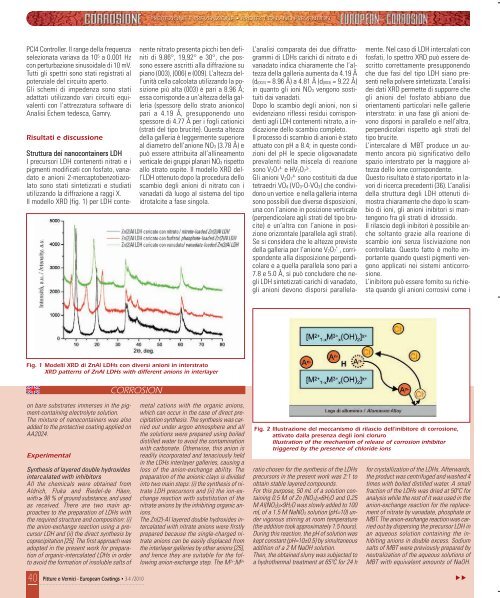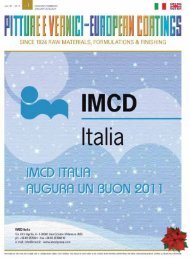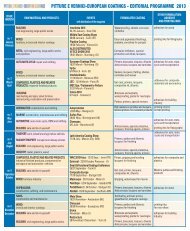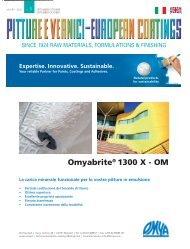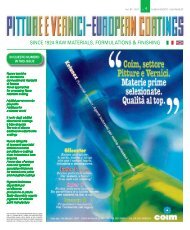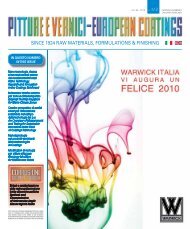Create successful ePaper yourself
Turn your PDF publications into a flip-book with our unique Google optimized e-Paper software.
PCI4 Controller. Il range della frequenza<br />
selezionata variava da 10 5 a 0.001 Hz<br />
con perturbazione sinusoidale di 10 mV.<br />
Tutti gli spettri sono stati registrati al<br />
potenziale del circuito aperto.<br />
Gli schemi di impedenza sono stati<br />
adattati utilizzando vari circuiti equivalenti<br />
con l’attrezzatura software di<br />
Analisi Echem tedesca, Gamry.<br />
Risultati e discussione<br />
Struttura dei nanocontainers LDH<br />
I precursori LDH contenenti nitrati e i<br />
pigmenti modificati con fosfato, vanadato<br />
e anioni 2-mercaptobenzotiazolato<br />
sono stati sintetizzati e studiati<br />
utilizzando la diffrazione a raggi X.<br />
Il modello XRD (fig. 1) per LDH conte-<br />
nente nitrato presenta picchi ben definiti<br />
di 9.86°, 19,92° e 30°, che possono<br />
essere ascritti alla diffrazione su<br />
piano (003), (006) e (009). L’altezza dell’unità<br />
cella calcolata utilizzando la posizione<br />
più alta (003) è pari a 8.96 Å;<br />
essa corrisponde a un’altezza della galleria<br />
(spessore dello strato anionico)<br />
pari a 4.19 Å, presupponendo uno<br />
spessore di 4.77 Å per i fogli cationici<br />
(strati del tipo brucite). Questa altezza<br />
della galleria è leggermente superiore<br />
al diametro dell’anione NO3 (3.78 Å) e<br />
può essere attribuita all’allineamento<br />
verticale dei gruppi planari NO3 rispetto<br />
allo strato ospite. Il modello XRD dell’LDH<br />
ottenuto dopo la procedura dello<br />
scambio degli anioni di nitrato con i<br />
vanadati dà luogo al sistema del tipo<br />
idrotalcite a fase singola.<br />
Fig. 1 Modelli XRD di ZnAl LDHs con diversi anioni in interstrato<br />
XRD patterns of ZnAl LDHs with different anions in interlayer<br />
on bare substrates immerses in the pigment-containing<br />
electrolyte solution.<br />
The mixture of nanocontainers was also<br />
added to the protective coating applied on<br />
AA2024.<br />
Experimental<br />
Synthesis of layered double hydroxides<br />
intercalated with inhibitors<br />
All the chemicals were obtained from<br />
Aldrich, Fluka and Riedel-de Häen,<br />
with ≥ 98 % of ground substance, and used<br />
as received. There are two main approaches<br />
to the preparation of LDHs with<br />
the required structure and composition: (i)<br />
the anion-exchange reaction using a precursor<br />
LDH and (ii) the direct synthesis by<br />
coprecipitation [25]. The first approach was<br />
adopted in the present work for preparation<br />
of organic-intercalated LDHs in order<br />
to avoid the formation of insoluble salts of<br />
CORROSION<br />
metal cations with the organic anions,<br />
which can occur in the case of direct precipitation<br />
synthesis. The synthesis was carried<br />
out under argon atmosphere and all<br />
the solutions were prepared using boiled<br />
distilled water to avoid the contamination<br />
with carbonate. Otherwise, this anion is<br />
readily incorporated and tenaciously held<br />
in the LDHs interlayer galleries, causing a<br />
loss of the anion-exchange ability. The<br />
preparation of the anionic clays is divided<br />
into two main steps: (i) the synthesis of nitrate<br />
LDH precursors and (ii) the ion-exchange<br />
reaction with substitution of the<br />
nitrate anions by the inhibiting organic anions.<br />
The Zn(2)-Al layered double hydroxides intercalated<br />
with nitrate anions were firstly<br />
prepared because the single-charged nitrate<br />
anions can be easily displaced from<br />
the interlayer galleries by other anions [25],<br />
and hence they are suitable for the following<br />
anion-exchange step. The M 2+ :M 3+<br />
L’analisi comparata dei due diffrattogrammi<br />
di LDHs carichi di nitrato e di<br />
vanadato indica chiaramente che l’altezza<br />
della galleria aumenta da 4.19 Å<br />
(d(003) = 8.96 Å) a 4.81 Å (d(003) = 9.22 Å)<br />
in quanto gli ioni NO3 vengono sostituiti<br />
dai vanadati.<br />
Dopo lo scambio degli anioni, non si<br />
evidenziano riflessi residui corrispondenti<br />
agli LDH contenenti nitrato, a indicazione<br />
dello scambio completo.<br />
Il processo di scambio di anioni è stato<br />
attuato con pH a 8.4; in queste condizioni<br />
del pH le specie oligovanadate<br />
prevalenti nella miscela di reazione<br />
sono V2O7 4- e HV2O7 3- .<br />
Gli anioni V2O7 4- sono costituiti da due<br />
tetraedri VO4 (VO3-O-VO3) che condividono<br />
un vertice e nella galleria interna<br />
sono possibili due diverse disposizioni,<br />
una con l’anione in posizione verticale<br />
(perpendicolare agli strati del tipo brucite)<br />
e un’altra con l’anione in posizione<br />
orizzontale (parallela agli strati).<br />
Se si considera che le altezze previste<br />
della galleria per l’anione V2O7 4-<br />
, corrispondente<br />
alla disposizione perpendicolare<br />
e a quella parallela sono pari a<br />
7.8 e 5.0 Å, si può concludere che negli<br />
LDH sintetizzati carichi di vanadato,<br />
gli anioni devono disporsi parallela-<br />
ratio chosen for the synthesis of the LDHs<br />
precursors in the present work was 2:1 to<br />
obtain stable layered compounds.<br />
For this purpose, 50 mL of a solution containing<br />
0.5 M of Zn (NO3)2×6H2O and 0.25<br />
M Al(NO3)3×9H2O was slowly added to 100<br />
mL of a 1.5 M NaNO3 solution (pH=10) under<br />
vigorous stirring at room temperature<br />
(the addition took approximately 1.5 hours).<br />
During this reaction, the pH of solution was<br />
kept constant (pH=10±0.5) by simultaneous<br />
addition of a 2 M NaOH solution.<br />
Then, the obtained slurry was subjected to<br />
a hydro thermal treatment at 65ºC for 24 h<br />
mente. Nel caso di LDH intercalati con<br />
fosfati, lo spettro XRD può essere descritto<br />
correttamente presupponendo<br />
che due fasi del tipo LDH siano presenti<br />
nella polvere sintetizzata. L’analisi<br />
dei dati XRD permette di supporre che<br />
gli anioni del fosfato abbiano due<br />
orientamenti particolari nelle gallerie<br />
interstrato: in una fase gli anioni devono<br />
disporsi in parallelo e nell’altra,<br />
perpendicolari rispetto agli strati del<br />
tipo brucite.<br />
L’intercalare di MBT produce un aumento<br />
ancora più significativo dello<br />
spazio interstrato per la maggiore altezza<br />
dello ione corrispondente.<br />
Questo risultato è stato riportato in lavori<br />
di ricerca precedenti (36). L’analisi<br />
della struttura degli LDH ottenuti dimostra<br />
chiaramente che dopo lo scambio<br />
di ioni, gli anioni inibitori si mantengono<br />
fra gli strati di idrossido.<br />
Il rilascio degli inibitori è possibile anche<br />
soltanto grazie alla reazione di<br />
scambio ioni senza lisciviazione non<br />
controllata. Questo fatto è molto importante<br />
quando questi pigmenti vengono<br />
applicati nei sistemi anticorrosione.<br />
L’inibitore può essere fornito su richiesta<br />
quando gli anioni corrosivi come i<br />
Fig. 2 Illustrazione del meccanismo di rilascio dell’inibitore di corrosione,<br />
attivato dalla presenza degli ioni cloruro<br />
Illustration of the mechanism of release of corrosion inhibitor<br />
triggered by the presence of chloride ions<br />
for crystallization of the LDHs. Afterwards,<br />
the product was centrifuged and washed 4<br />
times with boiled distilled water. A small<br />
fraction of the LDHs was dried at 50ºC for<br />
analysis while the rest of it was used in the<br />
anion-exchange reaction for the replacement<br />
of nitrate by vanadate, phosphate or<br />
MBT. The anion-exchange reaction was carried<br />
out by dispersing the precursor LDH in<br />
an aqueous solution containing the inhibiting<br />
anions in double excess. Sodium<br />
salts of MBT were previously prepared by<br />
neutralization of the aqueous solutions of<br />
MBT with equivalent amounts of NaOH.<br />
40 Pitture e Vernici - European Coatings • 3-4 /<strong>2010</strong><br />
▼<br />
▼


